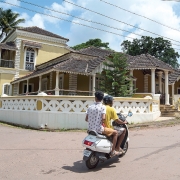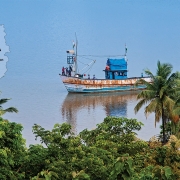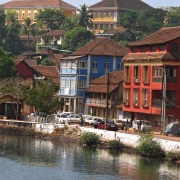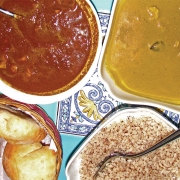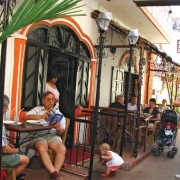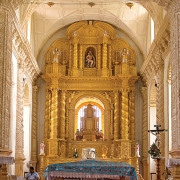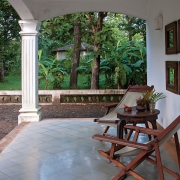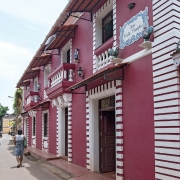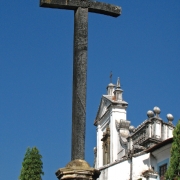
Etcetera
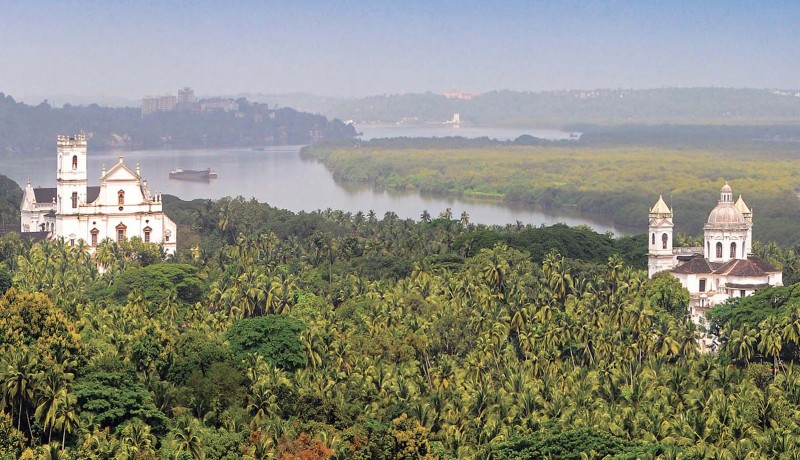
The Latin Quarter of Panaji wears its colonial heart on its sleeve.
Goa was just a blip on the map of India till the 1960s. Then, suddenly, the tiny former Portuguese colony found itself in the spotlight thanks to the flower children from around the globe who headed here to meditate on their navels and seek peace in a troubled world.
Their descendants, the modern-day backpackers, too, file into Goa in search of the Holy Grail of peace or to find their inner selves; to open their Third Eye or even to zone out on trance at underground rave parties on the beaches of North Goa.
Many, however, are in search of the other Goa; its Portuguese heart that throbs in pockets like Old Goa, in Fontainhas, the Latin Quarter of Panaji, and on the atmospheric sleepy island of Divar, accessed by a short two-minute ferry ride. Yes, Goa has multiple avatars—it’s a party destination, a former sleepy Portuguese colony, a beach hangout, a sliver of rural India. That said, we love Goa any which way. But what we find most intriguing is its colonial core. The Portuguese left Goa in 1961 but the love affair between the colonisers and the colonised continues even today, and most passionately in Fontainhas.
Fontainhas lies in the heart of Panaji at the foot of Altinho, a swish hilltop area, and Ourem Creek and seems adrift in a sea of nostalgia. It is a “small chunk of Portugal washed up on the shores of the Indian Ocean”, as writer William Dalrymple has said.
In the course of our frequent wanderings in this quarter, we would often hear the strain of a sad fado, a Portuguese genre of music, which would waft out of a window while further down, the strum of a guitar would override a muscular tenor belting out an Italian opera.
On a recent visit, we started our stroll from the northern end, near the petite Sao Tome Church where a group of silver Goan ladies in outmoded frocks conversed with venerable gentlemen wielding ornate walking sticks. They seemed to enhance the period setting and infuse it with flesh and blood.
From the Sao Tome neighbourhood, spaghetti-thin, sunlit alleys snake away amid traditional Portuguese style homes with overhanging trellised balconies and red-tiled roofs. The facades glow in the Mediterranean colours of ochre, green, blue and red, and give the neighbourhood an aura of having been plucked out of the Iberian Peninsula. In small dim tavernas, locals quaff feni in a convivial circle of friends and cafes and eateries, wreathed in the aroma of Portuguese-Goan cuisine, resonate with beer-fuelled laughter. The Sao Tome quarter lies around the main post office, which was the tobacco trading house in the Portuguese era, with the adjacent building serving as the mint, according to our guide.
The square facing these buildings has a bloody history—it was the scene of executions, attended by townspeople in the mood for some gory ‘entertainment’! The conspirators of the Pinto Revolt were also put to death here for their part in an aborted coup to dislodge the Portuguese in 1787. In contrast to the bloody goings-on, we stumbled on a beautifully restored building nearby called the Fundacao Oriente, an institution that restores heritage buildings and safeguards the syncretic culture of the state.
Indeed, the vintage buildings in Fontainhas—some are immaculate while others stand proud despite peeling paint—line streets with lyrical names such as Rua de Natal, Avenida Dom Joao, and Cunha Rivara. We often felt like we were in Lisbon! On the charmingly named Rua 31 de Janeiro stands one of the oldest bakeries in Panaji. While we waited in the bakery to buy a couple of fresh poee, Goan bread with a crusty exterior and a warm heart, a delightful intermingling of accents wafted around us—the lilt of Konkani and fragments of Portuguese spoken by a gracious dowager who could have stepped out of a colonial portrait! We overheard two little girls debating the existence of an all-powerful God while they shared a chicken pasty and then moved on to more childlike topics.
Fontainhas brims with such encounters and over several holidays in Goa, we have wandered its intimate streets where life is lived in the open. On an earlier visit, we had purchased a few utilitarian items from a small provision store in the neighbourhood and struck up a conversation with the diminutive owner whose toothy grin and warmth disarmed us completely. “I have two sons and a bus,” she had confided even as we wondered about clubbing one’s tangible assets in such an unusual manner. And then we understood why. In a laidback world where the rat race is an alien concept, life is lived in the slow lane. “One drives the bus and the other collects the fare,” she said proudly. A perfect arrangement in a near-perfect world!
Some of the colonial quarter’s iconic buildings are the French-sounding La Maison Fontainhas, a spiffy homestay that wears its colonial heart on its sleeve and the WelcomHeritage Panjim Inn, with its deep red façade and white trimmings. A 19th century heritage inn studded with period furniture, it was o ce the favourite hangout of the flower children, and memories of those times of rebellion, peace signs and free love still seem to cling to it. Carved four poster beds, rosewood cupboards and dressers are wreathed in nostalgia for an era that will never return.
Part of the Panjim Inn group is the WelcomHeritage Panjim Pousada, across the road, which started life as the only Hindu house in a predominantly Catholic precinct. It belonged to the affluent Ghanekar family and was rebuilt in the 1930s. The Pousada includes the four heritage rooms of Panjim Peoples, Goa’s first English school. In the central courtyard, a tulsi plant occupies pride of place while artworks glow on whitewashed walls. The interiors are redolent of a prosperous Hindu colonial home with carved four-poster beds, tasteful furnishings and artworks.
It was in the pretty whitewashed Chapel of Saint Sebastian, awash in peace, that we experienced a visceral fear. There, in its dimly lit interior, is a striking crucifix with an unusual image of Jesus—his eyes are open and piercing and glower at the viewer. The crucifix once stood in the Palace of the Inquisition in Old Goa and was said to have been designed to strike terror in the hearts of non-believers brought before the fearsome Inquisitors who would later consign them to their gruesome fate.
Also in Fontainhas, one can bite into the luscious Portuguese culinary legacy in eateries like Viva Panjim, located in a period Goan house with a few tables on the narrow patio outside. The gracious Goan owner advises customers on which classic to try that afternoon—chicken done in the xacuti or cafreal style or seafood such as the kingfish vindaloo followed by the multi-layered bebinca.
Venite, a hippy outpost of yesteryear and now a quirky eatery with graffiti on the walls and beer bottle chandeliers, is located on the first floor of a 200 year-old building. It was one of the first inns in Panaji and today its wide-ranging menu includes the day’s catch turned out in the typical Goan, Continental or Portuguese style. The restaurant, with its small wood tables and chairs and miniscule balconies, is also famed for its pork chops and other Goan classics.
However, our favourite is a linen-less eatery, close to Fontainhas, which brims with regulars—including a few inebriated ones—and good cheer. There, we once met a Goan lady of Portuguese descent with a classic profile who smoked and drank beer with an air of sheer class. We struck up a conversation with her, and soon a silver gentleman joined in and there was rollicking banter all around. He suddenly stopped to apologise for the whistling sound that emanated after each sentence that he uttered. “I have very few teeth left and I forgot my dentures at home,” he said candidly. Instant friendships and instant revelations. That’s the Goan way, we thought.
After a delicious meal, we often take a local bus heading to Old Goa. With courtesy so ingrained in the Goan, the conductor whistles the bus to a stop every time he spots a silver at an unscheduled stop.
This time around, we wanted to experience hinterland Goa and stayed at Champakali, a homestay with a heart near Old Goa, which bills itself as two homes on a hill by the river. Nestling in tangled greenery and tall-as-totem-poles teak trees with a banyan as the centrepiece, Champakali felt like a continuation of the Portuguese legacy of susegad, a Goan-Konkani word that means laid back and relaxed. Leisurely breakfasts and teas in the gazebo; full-bellied afternoon naps in our breezy high-ceilinged room after days spent burrowing in the untold mysteries of Fontainhas, Old Goa and the dreamy island of Divar.
Not for us the pulsating beaches of Goa captured in tourist brochure clichés; where banana boats ride the waves, paragliders drift on the wind, bars throb with almost asthmatic fervour and night markets flog tired old goods. We prefer dewy mornings filled with bird calls and the sight of tousled palms as we sip morning tea on the wraparound veranda of our villa; dreamy candle-lit dinners with the soundtrack of the breeze soughing through the palms. That’s when we realise why we—and perhaps many of the flower children—fell in love with Goa.
FACTFILE
GETTING THERE
By air: Dabolim airport is about 26 km from Panaji.
By rail: Vasco da Gama, the nearest railhead, is about 29 km away. Madgaon, another major railway station, is 38 km away.
By road: Maharashtra State Road Transport Corporation and Karnataka State Road Transport Corporation are some of the prime operators providing bus services from nearby cities such as Mumbai, Pune and Bengaluru. Those driving from these cities can take NH 4, while those coming from Mangaluru can take NH 17.
ACCOMMODATION
By way of accommodation, Goa has a full range to offer: from deluxe five-star hotels to budget lodges and tourist complexes run by Goa Tourism. However, Champakali, a 15-minute walk from Old Goa and a short drive from Panaji, is a heavenly option for those who want to get away from touristy Goa. Tel: 098504 64325
For more information, visit Goa Tourism at goa-tourism.com
Text & Photographs by Gustasp and Jeroo Irani Featured in Harmony — Celebrate Age Magazine January 2017
you may also like to read
-
Cracking the longevity code
Small yet impactful choices can be game-changers, writes Srirekha Pillai At 102, there’s no stopping Chandigarh-based Man Kaur, the world’s….
-
Home, not alone
While a regulatory framework is vital for senior-care facilities, the need of the hour is to develop an ecosystem to….
-
Birthday Girl
Published in a special edition to honour Japanese master storyteller Haruki Murakami’s 70th birthday, Birthday Girl (Penguin; Rs 100; 42….
-
A huge treat for music lovers
Published as the revised and updated second edition, Incomparable Sachin Dev Burman (Blue Pencil; Rs. 599; 470 pages) the authoritative….



